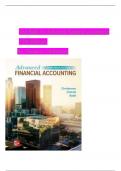Exam (elaborations)
SOLUTIONS MANUAL for Advanced Financial Accounting, 13th Edition. By Theodore Christensen, David Cottrell and Cassy Budd _ Complete Download.
Test Bank For Advanced Financial Accounting 13th Edition By Theodore Christensen, Complete Chapters 1 - 20, Verified Newest Version Test Bank For Advanced Financial Accounting 13th Edition By Theodore Christensen, Complete Chapters 1 - 20, Verified Newest Version Test Bank For Advanced Financial Ac...
[Show more]




